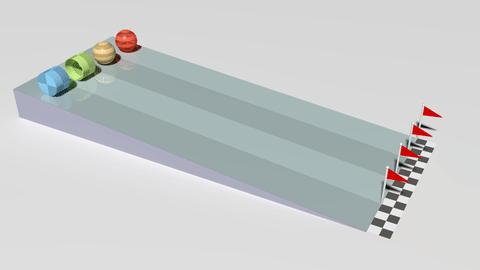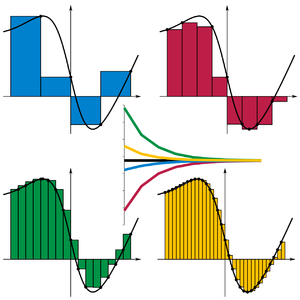微積分 (粵拼 :mei4 zik1 fan1 英文 :calculus ,拉丁文 入面用嚟計數嘅石仔)係數學 一門,屬基礎學科,內容主要包括極限 、微分 同積分 嘅應用。微積分係微分同積分兩門學問嘅統稱,研究嘅範疇有三個,包括微分、積分,同埋微分同積分之間嘅關係。微分主要講一個變量點樣隨時間(或者其他變量)改變,而積分就主要講計算面積嘅方法。佢哋兩個嘅關係由「微積分基本定理 」呢個定理講,喺適當嘅條件下,求積分同求微分互為相反嘅過程。
數列 (sequence)係一種同函數好有啦掕嘅數學物體 。一個數列會好似一個集 (set)噉由一柞元素 組成;而同集唔同,數列係有特定次序嘅,即係例如一個由數組成嘅數列會分「邊個係排第 1 嗰個數」、「邊個係排第 2 嗰個數」... 等等-每個元素都掕住個自然數
n
{\displaystyle n}
[ 1] [ 2]
例:
x
n
=
(
2
,
4
,
6
,
8
,
10
,
⋯
)
{\displaystyle x_{n}=(2,4,6,8,10,\cdots )}
而且一個數列可以同一款元素出現喺個數列嘅唔同位置,
例:
x
n
=
(
2
,
4
,
6
,
2
,
4
,
⋯
)
{\displaystyle x_{n}=(2,4,6,2,4,\cdots )}
數列可以當係函數 嘅一種,指「會將自然數 (
n
{\displaystyle n}
n
{\displaystyle n}
[ 1]
數列嘅一個重要特徵係可以匯合 (converge):想像有個由數組成嘅數列
a
n
=
(
a
0
,
a
1
,
a
2
,
.
.
.
)
{\displaystyle a_{n}=(a_{0},a_{1},a_{2},...)}
n
{\displaystyle n}
n
{\displaystyle n}
n
{\displaystyle n}
x
{\displaystyle x}
∣
x
−
a
n
∣
{\displaystyle \mid x-a_{n}\mid }
數學符號 嚟表達嘅話係噉樣[ 1]
lim
n
→
∞
a
n
=
x
{\displaystyle \lim _{n\to \infty }a_{n}=x}
上述呢條式用日常用語講,係指「隨住
n
{\displaystyle n}
無限大 (
∞
{\displaystyle \infty }
a
n
{\displaystyle a_{n}}
x
{\displaystyle x}
a
n
{\displaystyle a_{n}}
極限 (limit),而呢個極限就係
x
{\displaystyle x}
打戙嗰條軸 做
a
n
{\displaystyle a_{n}}
打橫嗰條軸 就做
n
{\displaystyle n}
x
=
0
{\displaystyle x=0}
想像家陣將
f
{\displaystyle f}
直線 ,當中 Y 軸 表示
f
(
x
)
{\displaystyle f(x)}
X 軸 表示
x
{\displaystyle x}
f
{\displaystyle f}
(
x
1
,
y
1
)
{\displaystyle (x_{1},y_{1})}
(
x
2
,
y
2
)
{\displaystyle (x_{2},y_{2})}
直線 (附圖 1),噉條線喺
(
x
1
,
y
1
)
{\displaystyle (x_{1},y_{1})}
(
x
2
,
y
2
)
{\displaystyle (x_{2},y_{2})}
斜率
m
{\displaystyle m}
定義 上係
m
=
bin faa
y
bin faa
x
=
y
2
−
y
1
x
2
−
x
1
=
Δ
y
Δ
x
{\displaystyle m={\frac {{\text{bin faa }}y}{{\text{bin faa }}x}}={\frac {y_{2}-y_{1}}{x_{2}-x_{1}}}={\frac {\Delta y}{\Delta x}}}
當中「
Δ
{\displaystyle \Delta }
希臘字母 Δ (delta),喺數學 上意思係「... 嘅改變」噉解,即係「
Δ
y
{\displaystyle \Delta y}
y
{\displaystyle y}
y
2
−
y
1
{\displaystyle y_{2}-y_{1}}
m
{\displaystyle m}
y
{\displaystyle y}
x
{\displaystyle x}
變率 」[ 3] [ 4]
f
{\displaystyle f}
複雜 嘅曲線 ,例如噉:
呢條線嘅斜率會隨
x
{\displaystyle x}
(
a
,
f
(
a
)
)
{\displaystyle (a,f(a))}
(
a
+
h
,
f
(
a
+
h
)
)
{\displaystyle (a+h,f(a+h))}
h
{\displaystyle h}
f
(
x
)
{\displaystyle f(x)}
x
{\displaystyle x}
[ 3] [ 4]
Δ
f
(
x
)
Δ
x
=
f
(
a
+
h
)
−
f
(
a
)
h
{\displaystyle {\begin{aligned}{\frac {\Delta f(x)}{\Delta x}}&={\frac {f(a+h)-f(a)}{h}}\end{aligned}}}
微分 (differentation)嘅做法建基於函數極限嘅諗頭,嚟表達一個函數嘅瞬間變率 :而家想像將
h
{\displaystyle h}
f
(
x
)
{\displaystyle f(x)}
x
{\displaystyle x}
導數 (derivative),
f
′
(
x
)
{\displaystyle f'(x)}
f
′
(
x
)
=
lim
h
→
0
f
(
x
+
h
)
−
f
(
x
)
h
{\displaystyle {\begin{aligned}f'(x)&=\lim _{h\to 0}{\frac {f(x+h)-f(x)}{h}}\end{aligned}}}
h
{\displaystyle h}
無窮小量 (infinitesimal)-無限咁接近 0、但仲係大過 0。用日常用語講嘅話,即係話如果將一條曲線斬開做好多極細嘅橛,如果啲橛仔夠細,噉每一橛仔都可以當成一條好短嘅直線,有一個可以有方法決定嘅斜率。如果用圖像方法表示,可以想像下圖條紅色曲線嘅情況(兩個細圓圈表示考慮緊嗰兩點)-隨住考慮緊嗰兩點之間嘅
x
{\displaystyle x}
h
{\displaystyle h}
[ 3] [ 4]
因為自然科學 同工程學 會用函數描述好多嘢(自然現象同人造嘅系統),所以瞬間變率同埋建基於瞬間變率嘅函數分析方法喺好多科學同工程學上嘅研究裏面都有用[ 3] [ 4] 牛頓力學 就會用到導數嘅概念,將速度 (
v
{\displaystyle \mathbf {v} }
位移 (
r
{\displaystyle \mathbf {r} }
時間 (
t
{\displaystyle t}
加速度 (
a
{\displaystyle \mathbf {a} }
[ 5]
v
=
Δ
r
Δ
t
{\displaystyle \mathbf {v} ={\Delta \mathbf {r} \over \Delta {t}}}
a
=
Δ
v
Δ
t
{\displaystyle \mathbf {a} ={\Delta \mathbf {v} \over \Delta {t}}}
呢幾嚿嘢因為材料 等嘅原因而以唔同嘅速度 同加速度 郁動,不過佢哋嘅
v
{\displaystyle \mathbf {v} }
r
{\displaystyle \mathbf {r} }
t
{\displaystyle t}
簡單例子:假想依家已知
r
=
C
t
{\displaystyle \mathbf {r} ={\text{C}}t}
當中
C
{\displaystyle {\text{C}}}
常數 ;噉嘅話
f
′
(
t
)
=
C
(
t
+
h
)
−
C
t
h
{\displaystyle f'(t)={\frac {{\text{C}}(t+h)-{\text{C}}t}{h}}}
h
{\displaystyle h}
f
′
(
t
)
=
C
t
+
C
h
−
C
t
h
{\displaystyle f'(t)={\frac {{\text{C}}t+{\text{C}}h-{\text{C}}t}{h}}}
f
′
(
t
)
=
C
h
h
{\displaystyle f'(t)={\frac {{\text{C}}h}{h}}}
f
′
(
t
)
=
C
{\displaystyle f'(t)={\text{C}}}
-得出「
v
{\displaystyle \mathbf {v} }
f
′
(
t
)
{\displaystyle f'(t)}
[ 6]
r
{\displaystyle \mathbf {r} }
t
{\displaystyle t}
v
{\displaystyle \mathbf {v} }
t
{\displaystyle t}
a
{\displaystyle \mathbf {a} }
t
{\displaystyle t}
[ 註 1] 地球 環境下郁動 嘅物體 [ 7]
黎曼積分 嘅圖解:一條曲線 同 X 軸 之間嘅面積可以用「好多個極窄長方形嘅面積總和」嚟得出個大致數值。積分 (integral)係一個同微分 好有啦掕嘅概念。喺最簡單最基本嗰種黎曼積分 (Riemann integral)當中,積分係噉樣定義 嘅[ 8] [ 9]
f
{\displaystyle f}
y
=
f
(
x
)
{\displaystyle y=f(x)}
f
{\displaystyle f}
a
{\displaystyle a}
b
{\displaystyle b}
∫
a
b
f
(
x
)
d
x
{\displaystyle \int _{a}^{b}f(x)\,dx}
而黎曼積分嘅定義如下:
∫
a
b
f
(
x
)
d
x
≡
lim
max
Δ
x
k
→
0
∑
k
=
1
n
f
(
x
k
)
Δ
x
k
{\displaystyle \int _{a}^{b}f(x)\,dx\equiv \lim _{{\text{max }}\Delta x_{k}\to 0}\sum _{k=1}^{n}f(x_{k})\Delta x_{k}}
上述呢條式講嘅嘢係噉嘅:想像依家將函數
f
{\displaystyle f}
a
=
0
{\displaystyle a=0}
b
=
2
{\displaystyle b=2}
(
a
,
f
(
a
)
)
{\displaystyle (a,f(a))}
(
a
,
0
)
{\displaystyle (a,0)}
(
b
,
f
(
b
)
)
{\displaystyle (b,f(b))}
(
b
,
0
)
{\displaystyle (b,0)}
面積 係幾多,佢可以噉樣想像[ 8]
將
a
{\displaystyle a}
b
{\displaystyle b}
X 軸 斬開做
n
×
2
{\displaystyle n\times 2}
step
=
1
/
n
{\displaystyle {\text{step}}=1/n}
(
2
n
−
1
)
{\displaystyle (2n-1)}
長方形 喺條線之內;
由幅圖睇得出,响
n
=
1
{\displaystyle n=1}
但又想像依家
n
{\displaystyle n}
闊度 (
Δ
x
k
{\displaystyle \Delta x_{k}}
Δ
x
k
→
0
{\displaystyle \Delta x_{k}\to 0}
每一個呢啲極窄長方形嘅面積係
f
(
x
k
)
×
Δ
x
k
{\displaystyle f(x_{k})\times \Delta x_{k}}
f
(
x
k
)
{\displaystyle f(x_{k})}
Δ
x
k
{\displaystyle \Delta x_{k}}
∑
{\displaystyle \sum }
簡單講,如果話微分計嘅係一條曲線 上指定某一點嘅瞬間斜率,噉積分計嘅就係一條曲線指定某一個間距內(
a
{\displaystyle a}
b
{\displaystyle b}
X 軸 之間嘅面積[ 9]
因為積分其實可以諗做加法嘅連續版本,而喺物理學 入邊有好多嘅過程都係被想像成連續發生嘅,所以積分喺物理學入邊好有用。例如畀一個物體,佢嘅總質量 、質心 位置、旋轉慣性 、總能量 等等都可以用積分計出嚟。
喺牛頓運動定律 入面,一個物體嘅動量 變化係所有施加喺佢上面嘅力 加埋,亦即係話,動量變化可以透過對總力做積分搵出嚟。喺電磁學 方面,用微積分可以搵出一個電場 或者磁場 嘅總通量 。
積分可以話係將微分做嘅嘢掉返轉頭嚟做,而呢點係微積分基本定理 嘅重要一部份:簡單講嘅話,想像家陣有個函數
f
{\displaystyle f}
y
=
f
(
x
)
{\displaystyle y=f(x)}
f
′
(
x
)
=
Δ
y
Δ
x
{\displaystyle f'(x)={\frac {\Delta y}{\Delta x}}}
考慮呢個導數喺是但兩點
a
{\displaystyle a}
b
{\displaystyle b}
b
−
a
=
Δ
x
{\displaystyle b-a=\Delta x}
∫
a
b
f
′
(
x
)
d
x
{\displaystyle \int _{a}^{b}f'(x)\,dx}
呢個積分嘅數值會等同
f
′
(
x
)
×
Δ
x
{\displaystyle f'(x)\times \Delta x}
=
Δ
y
Δ
x
×
Δ
x
{\displaystyle ={\frac {\Delta y}{\Delta x}}\times \Delta x}
=
Δ
y
{\displaystyle =\Delta y}
用日常用語講嘅話,攞一個函數
f
{\displaystyle f}
導數
f
′
{\displaystyle f'}
b
−
a
=
Δ
x
{\displaystyle b-a=\Delta x}
f
′
{\displaystyle f'}
等同 函數
f
{\displaystyle f}
a
{\displaystyle a}
b
{\displaystyle b}
Δ
y
{\displaystyle \Delta y}
[ 10] [ 11]
∫
a
x
f
′
(
x
)
d
x
=
f
(
x
)
−
f
(
a
)
{\displaystyle \int _{a}^{x}f'(x)\,dx=f(x)-f(a)}
積分喺應用數學上都有廣泛嘅用途。例如係正話提到嗰個牛頓力學嘅例子噉,速度
v
{\displaystyle \mathbf {v} }
r
{\displaystyle \mathbf {r} }
t
{\displaystyle t}
v
{\displaystyle \mathbf {v} }
r
{\displaystyle \mathbf {r} }
[ 7] 變數 會點樣隨時間變化,所以結合微分同積分嘅分析做法-微積分-响呢啲領域上極之有用,可以攞嚟(例如)搵出能夠清楚精確噉表達嗮唔同嘅變數分別點樣隨時間變化嘅函數 [ 12]
↑ 1.0 1.1 1.2 Gaughan, Edward (2009). "1.1 Sequences and Convergence". Introduction to Analysis . AMS (2009).
↑ Falcon, Sergio (2003). "Fibonacci's multiplicative sequence". International Journal of Mathematical Education in Science and Technology . 34 (2): 310–315.
↑ 3.0 3.1 3.2 3.3 Courant, Richard; John, Fritz (December 22, 1998), Introduction to Calculus and Analysis , Vol. 1, Springer-Verlag.
↑ 4.0 4.1 4.2 4.3 Larson, Ron; Hostetler, Robert P.; Edwards, Bruce H. (February 28, 2006), Calculus: Early Transcendental Functions (4th ed.), Houghton Mifflin Company.
↑ Wilson, Edwin Bidwell (1901). Vector analysis: a text-book for the use of students of mathematics and physics , founded upon the lectures of J. Willard Gibbs. p. 125.
↑ Kinematics and Calculus . The Physics Hypertextbook .↑ 7.0 7.1 Kibble, Tom W.B.; Berkshire, Frank H. (2004). Classical Mechanics (5th ed.). Imperial College Press.
↑ 8.0 8.1 Jeffreys, H. and Jeffreys, B. S. Methods of Mathematical Physics , 3rd ed. Cambridge, England: Cambridge University Press, p. 29, (1988).
↑ 9.0 9.1 Anton, Howard; Bivens, Irl C.; Davis, Stephen (2016), Calculus: Early Transcendentals (11th ed.), John Wiley & Sons.
↑ Kowalk, W. P., Integration Theory , University of Oldenburg. A new concept to an old problem.
↑ Apostol, Tom M. (1967). Calculus, Vol. 1: One-Variable Calculus with an Introduction to Linear Algebra (2nd ed.), Wiley. p. 202.
↑ Coombes, K. R., Lipsman, R. L., & Rosenberg, J. M. (2012). Multivariable Calculus and Mathematica®: With Applications to Geometry and Physics . Springer Science & Business Media.











































































